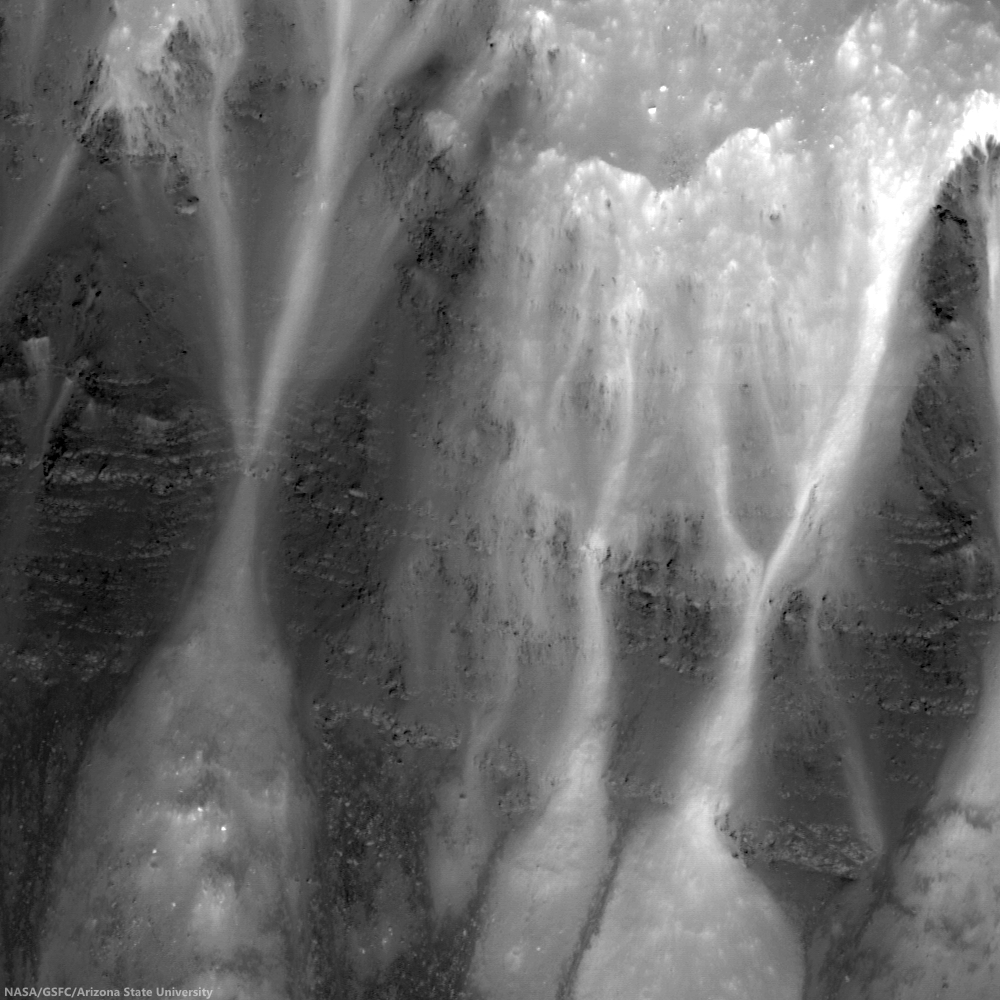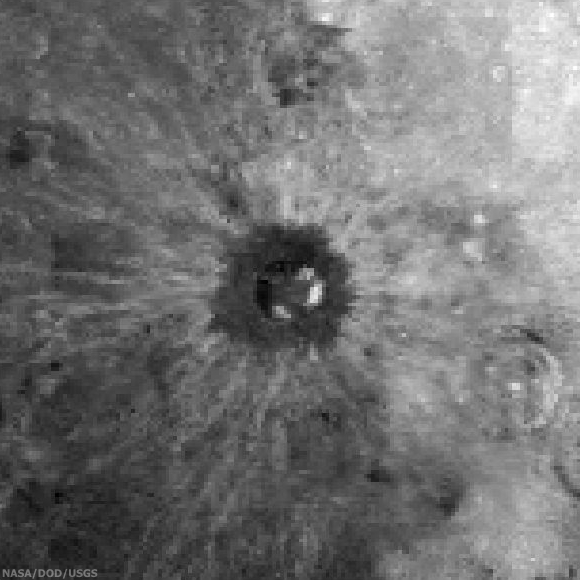 |
| Bright talus winds downslope through crags and crannies in the banded scarps exposed in the east wall of Dionysius crater. Horizontal lineations result from differential mass wasting of stratified rock in Mare Tranquillitatis; High (35.12°) incidence Narrow Angle Camera (NAC) mosaic, from both left and right frames, from LROC observation M137434784, orbit 5387, August 26, 2010; east is up in this 450 meter field of view, 49 cm per pixel resolution [NASA/GSFC/Arizona State University]. |
J. Stopar
LROC News System
Dionysius crater (2.766°N, 17.297°E) is situated on the western edge of Mare Tranquillitatis (the Sea of Tranquility) and excavates both highlands (bright, high reflectance) and mare (dark, low reflectance) materials. Dark banded layers of mare peek out of the eastern wall, where mare material was disturbed by the impact that formed Dionysius crater. Bright talus trails wind downslope through crags and crannies in the dark mare scarps.
Looking closely, the mare appears banded or striated, indicating a non-uniform material. In general, mare are thought to form from large volumes of fluid lavas, much like the Columbia River Basalts in the Pacific Northwest of North America. The stratifications in the lunar mare may represent a series of lava flows in the region.
Blocky overhangs indicate areas more resistant to mass wasting and are interpreted as more coherent basaltic (mare) materials. The thinner, more finely grained layers might represent boundaries between individual lava flows or they may indicate changes in physical properties within a single flow unit. Some of the fine grained layers may even consist of paleoregoliths, ancient regolith surfaces exposed to the vacuum of space in between volcanic eruptions.
Explore the full NAC image, HERE.
Visit these other craters with layered mare exposures:
Lava Flows Exposed in Bessel Crater
Layering in Messier A
Layering in Euler Crater
Layers in Lucian Crater
Marius A
Galilaei's Layered Wall
Dawes
Dionysius Detour
LROC News System
Dionysius crater (2.766°N, 17.297°E) is situated on the western edge of Mare Tranquillitatis (the Sea of Tranquility) and excavates both highlands (bright, high reflectance) and mare (dark, low reflectance) materials. Dark banded layers of mare peek out of the eastern wall, where mare material was disturbed by the impact that formed Dionysius crater. Bright talus trails wind downslope through crags and crannies in the dark mare scarps.
Looking closely, the mare appears banded or striated, indicating a non-uniform material. In general, mare are thought to form from large volumes of fluid lavas, much like the Columbia River Basalts in the Pacific Northwest of North America. The stratifications in the lunar mare may represent a series of lava flows in the region.
Blocky overhangs indicate areas more resistant to mass wasting and are interpreted as more coherent basaltic (mare) materials. The thinner, more finely grained layers might represent boundaries between individual lava flows or they may indicate changes in physical properties within a single flow unit. Some of the fine grained layers may even consist of paleoregoliths, ancient regolith surfaces exposed to the vacuum of space in between volcanic eruptions.
Explore the full NAC image, HERE.
Visit these other craters with layered mare exposures:
Lava Flows Exposed in Bessel Crater
Layering in Messier A
Layering in Euler Crater
Layers in Lucian Crater
Marius A
Galilaei's Layered Wall
Dawes
Dionysius Detour




No comments:
Post a Comment